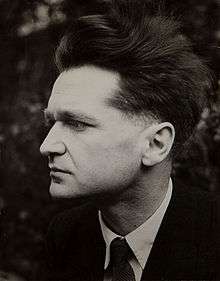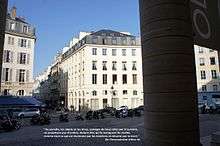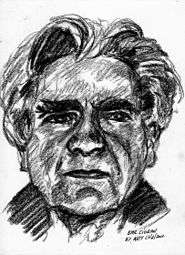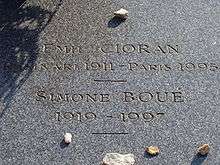Emil Cioran
| Emil Cioran | |
|---|---|
 | |
| Born |
Emil Mihai Cioran 8 April 1911 Resinár, Austria-Hungary (present-day Rășinari, Romania) |
| Died |
21 June 1995 (aged 84) Paris, France |
| Era | 20th-century philosophy |
| Region | Western philosophy |
| School | Philosophical pessimism, Existentialism |
Main interests | Suicide, nihilism, ethics, literature |
|
Influenced
| |
Emil Cioran (Romanian pronunciation: [eˈmil t͡ʃoˈran]; 8 April 1911 – 20 June 1995) was a Romanian philosopher and essayist, who published works in both Romanian and French. Cioran was born in Resinár (Rășinari), Szeben County, which was part of Austria-Hungary at the time. His work has been noted for its pervasive philosophical pessimism, and frequently engaged with issues of suffering, decay, and nihilism. Among his best known works are On the Heights of Despair (1934) and The Trouble with Being Born (1973). Cioran's first French book, A Short History of Decay, was awarded the prestigious Rivarol Prize in 1950. The Latin Quarter of Paris was his permanent residence and he lived much of his life in isolation with his partner Simone Boué.
Early life
Cioran was born in Resinár (Rășinari), Szeben County, which was part of Austria-Hungary at the time. His father, Emilian Cioran, was an orthodox priest, while his mother, Elvira (née Comaniciu), was originally from Veneția de Jos, a commune near Făgăraș.

After focusing on Humanities at the Gheorghe Lazăr High School in Sibiu (Hermannstadt), Cioran, at age 17, entered the University of Bucharest where he studied Philosophy and where he immediately met Eugène Ionesco and Mircea Eliade who became his lifelong friends. Future Romanian philosopher Constantin Noica and future Romanian thinker Petre Țuțea, became his closest academic colleagues as all studied under Tudor Vianu and Nae Ionescu. Cioran, Eliade, and Țuțea became supporters of the ideas of Nae Ionescu, deemed Trăirism, which fused Existentialism with various forms of Fascism.
Cioran had a good command of German. His early studies revolved around Immanuel Kant, Arthur Schopenhauer, and especially Friedrich Nietzsche. He became an agnostic, taking as an axiom "the inconvenience of existence". While at the University, he was influenced by the works of Georg Simmel, Ludwig Klages and Martin Heidegger, but also by the Russian philosopher Lev Shestov, whose contribution to Cioran’s central system of thought was the belief that life is arbitrary. Cioran's graduation thesis was on Henri Bergson whom he later rejected, claiming Bergson did not comprehend the tragedy of life.
Career
Berlin and Romania
In 1933, he received a scholarship to the University of Berlin, where he came into contact with Klages and Nicolai Hartmann. While in Berlin, he became interested in the policies of the Nazi regime, contributed a column to Vremea dealing with the topic (in which Cioran confessed that "there is no present-day politician that I see as more sympathetic and admirable than Hitler",[1] while expressing his approval for the Night of the Long Knives—"what has humanity lost if the lives of a few imbeciles were taken"),[2] and, in a letter written to Petru Comarnescu, described himself as "a Hitlerist".[3] He held similar views about Italian fascism, welcoming victories in the Second Italo-Abyssinian War, arguing that: "Fascism is a shock, without which Italy is a compromise comparable to today's Romania".[4]
Cioran’s first book, On the Heights of Despair (literally translated: "On the Summits of Despair"), was published in Romania in 1934. It was awarded the Commission’s Prize and the Young Writers Prize for one of the best books written by an unpublished young writer. Successively, The Book of Delusions (1935), The Transfiguration of Romania (1936), and Tears and Saints (1937), were also published in Romania (the first two titles have yet to be translated into English).
Although Cioran was never a member of the group, it was during this time in Romania that he began taking an interest in the ideas put forth by the Iron Guard—a far right organization whose nationalist ideology he supported until the early years of World War II, despite allegedly disapproving of their violent methods.
Cioran revised The Transfiguration of Romania heavily in its second edition released in the 1990s, eliminating numerous passages he considered extremist or "pretentious and stupid". In its original form, the book expressed sympathy for totalitarianism,[5] a view which was also present in various articles Cioran wrote at the time,[6] and which aimed to establish "urbanization and industrialization" as "the two obsessions of a rising people".[7] Marta Petreu's An Infamous Past: E.M. Cioran and the Rise of Fascism in Romania, published in English in 2005, gives an in-depth analysis of The Transfiguration.
His early call for modernization was, however, hard to reconcile with the traditionalism of the Iron Guard.[8] In 1934, he wrote, "I find that in Romania the sole fertile, creative, and invigorating nationalism can only be one which does not just dismiss tradition, but also denies and defeats it".[9] Disapproval of what he viewed as specifically Romanian traits had been present in his works ("In any maxim, in any proverb, in any reflection, our people expresses the same shyness in front of life, the same hesitation and resignation... [...] Everyday Romanian [truisms] are dumbfounding."),[10] which led to criticism from the far right Gândirea (its editor, Nichifor Crainic, had called The Transfiguration of Romania "a bloody, merciless, massacre of today's Romania, without even [the fear] of matricide and sacrilege"),[11] as well as from various Iron Guard papers.[12]
France


After coming back from Berlin (1936), Cioran taught philosophy at the "Andrei Șaguna" high school in Brașov for a year. In 1937, he left for Paris with a scholarship from the French Institute of Bucharest, which was then prolonged until 1944. After a short stay in his home country (November 1940-February 1941), Cioran never returned again. This last period in Romania was the one in which he exhibited a closer relationship with the Iron Guard, which had, by then, taken power (see National Legionary State) — on 28 November, he recorded a speech for the state-owned Romanian Radio, one centered on the portrait of Corneliu Zelea Codreanu, former leader of the movement, who had been killed two years before (praising him and the Guard for, among other things, "having given Romanians a purpose").[13]
He later renounced not only his support for the Iron Guard, but also their nationalist ideas, and frequently expressed regret and repentance for his emotional implication in it. For example, in a 1972 interview, he condemned it as "a complex of movements; more than this, a demented sect and a party", and avowed: "I found out then [...] what it means to be carried by the wave without the faintest trace of conviction. [...] I am now immune to it".[14]
In 1940, he started writing The Passionate Handbook, and finished it by 1945. It was to be the last book that he would write in Romanian, although not the last to deal with pessimism and misanthropy through delicate and lyrical aphorisms. From this point on Cioran only published books in French (all were appreciated not only because of their content, but also because of their style which was full of lyricism and fine use of the language).


In 1949 his first French book, A Short History of Decay, was published by Gallimard and was awarded the Rivarol Prize in 1950. Later on, Cioran refused every literary prize with which he was presented.
The Latin Quarter of Paris became Cioran’s permanent residence. He lived most of his life in isolation, avoiding the public. Yet, he still maintained numerous friends with whom he conversed often such as Mircea Eliade, Eugène Ionesco, Paul Celan, Samuel Beckett, Henri Michaux and Fernando Savater.
He is buried at the Montparnasse Cemetery.
Major themes and style
Professing a lack of interest in conventional philosophy in his early youth, Cioran dismissed abstract speculation in favor of personal reflection and passionate lyricism. "I’ve invented nothing; I’ve simply been the secretary of my sensations", he later said.
Pessimism characterizes all of his works, which many critics trace back to events of his childhood (in 1935 his mother is reputed to have told him that if she had known he was going to be so unhappy she would have aborted him). However, Cioran's pessimism (in fact, his skepticism, even nihilism) remains both inexhaustible and, in its own particular manner, joyful; it is not the sort of pessimism which can be traced back to simple origins, single origins themselves being questionable. When Cioran's mother spoke to him of abortion, he confessed that it did not disturb him, but made an extraordinary impression which led to an insight about the nature of existence ("I'm simply an accident. Why take it all so seriously?" is what he later said in reference to the incident).[15]
His works often depict an atmosphere of torment, a state that Cioran himself experienced, and came to be dominated by lyricism and, often, the expression of intense and even violent feeling. The books he wrote in Romanian especially display this latter characteristic. Preoccupied with the problems of death and suffering, he was attracted to the idea of suicide, believing it to be an idea that could help one go on living, an idea which he fully explored in On the Heights of Despair. He revisits suicide in depth in The New Gods, which contains a section of aphorisms devoted to the subject. The theme of human alienation, the most prominent existentialist theme, presented by Jean-Paul Sartre and Albert Camus, is thus formulated, in 1932, by young Cioran: "Is it possible that existence is our exile and nothingness our home?" in On the Heights of Despair.
Cioran’s works encompass many other themes as well: original sin, the tragic sense of history, the end of civilization, the refusal of consolation through faith, the obsession with the absolute, life as an expression of man's metaphysical exile, etc. He was a thinker passionate about history; widely reading the writers that were associated with the period of "decadent". One of these writers was Oswald Spengler who influenced Cioran's political philosophy in that he offered Gnostic reflections on the destiny of man and civilization. According to Cioran, as long as man has kept in touch with his origins and hasn't cut himself off from himself, he has resisted decadence. Today, he is on his way to his own destruction through self-objectification, impeccable production and reproduction, excess of self-analysis and transparency, and artificial triumph.
Regarding God, Cioran has noted that "without Bach, God would be a complete second rate figure" and that "Bach's music is the only argument proving the creation of the Universe cannot be regarded as a complete failure".[16] In an interview he stated that Bach had been a "kind of religion" for him. He mentioned that Bach and Dostoyevsky were the two great obsessions of his life, but that while his passion for Dostoyevsky ended up diminishing somewhat, his obsession with Bach "remained intact".
William H. Gass called Cioran's work "a philosophical romance on the modern themes of alienation, absurdity, boredom, futility, decay, the tyranny of history, the vulgarities of change, awareness as agony, reason as disease".
Cioran became most famous while writing not in Romanian but French, a language with which he had struggled since his youth. During Cioran's lifetime, Saint-John Perse called him “the greatest French writer to honor our language since the death of Paul Valéry.”[17] Cioran's tone and usage in his adopted language were seldom as harsh as in Romanian (though his use of Romanian is said to be more original).
Legacy
After the death of Cioran's long-term companion, Simone Boué, a collection of Cioran's manuscripts (over 30 notebooks) were found in the couple's apartment by a manager who tried, in 2005, to auction them. A decision taken by the Court of Appeal of Paris stopped the commercial sale of the collection. However, in March 2011, the Court of Appeal ruled that the seller was the legitimate owner of the manuscripts. Amid the manuscripts, which were mainly drafts of works that had already been published, an unedited journal was found which encompassed his life after 1972 (the year in which his Notebooks end). This document is probably Cioran’s last unpublished work.
An aged Cioran is the main character in a play by Romanian dramatist-actor Matei Vișniec, Mansardă la Paris cu vedere spre moarte ("A Paris Loft with a View on Death"). The play, depicting an imaginary meeting between Vișniec and Emil Cioran,[18] was first brought to the stage in 2007, under the direction of Radu Afrim and with a cast of Romanian and Luxembourgian actors; Cioran was played by Constantin Cojocaru.[19] Stagings were organized in the Romanian city of Sibiu[18][19] and in the Luxembourg, at Esch-sur-Alzette (both Sibiu and Luxembourg City were the year's European Capital of Culture).[18] In 2009, the Romanian Academy granted posthumous membership to Cioran.[20]
Major works
Romanian
- Pe culmile disperării (literally On the Summits of Despair; translated "On the Heights of Despair"), Editura "Fundația pentru Literatură și Artă", Bucharest 1934
- Cartea amăgirilor ("The Book of Delusions”), Bucharest 1936
- Schimbarea la față a României ("The Transfiguration of Romania”), Bucharest 1936
- Lacrimi și Sfinți ("Tears and Saints"), "Editura autorului" 1937
- Îndreptar pătimaș ("The Passionate Handbook”), Humanitas, Bucharest 1991
French
- Précis de décomposition ("A Short History of Decay"), Gallimard 1949
- Syllogismes de l'amertume (tr. "All Gall Is Divided"), Gallimard 1952
- La Tentation d'exister ("The Temptation to Exist"), Gallimard 1956 | English edition: ISBN 978-0-226-10675-5
- Histoire et utopie ("History and Utopia"), Gallimard 1960
- La Chute dans le temps ("The Fall into Time"), Gallimard 1964
- Le Mauvais démiurge (literally The Evil Demiurge; tr. "The New Gods"), Gallimard 1969
- De l'inconvénient d'être né ("The Trouble With Being Born"), Gallimard 1973
- Écartèlement (tr. "Drawn and Quartered"), Gallimard 1979
- Exercices d'admiration 1986, and Aveux et anathèmes 1987 (tr. and grouped as "Anathemas and Admirations")
- Œuvres (Collected works), Gallimard-Quatro 1995
- Mon pays/Țara mea ("My country”, written in French, the book was first published in Romania in a bilingual volume), Humanitas, Bucharest, 1996
- Cahiers ("Notebooks"), Gallimard 1997
- Des larmes et des saints , L'Herne | English edition: ISBN 978-0-226-10672-4
- Sur les cimes du désespoir, L'Herne, | English edition: ISBN 978-0-226-10670-0
- Le Crépuscule des pensées, L'Herne,
- Jadis et naguère, L'Herne
- Valéry face à ses idoles, L'Herne, 1970, 2006
- De la France, L’Herne, 2009
- Transfiguration de la Roumanie, L’Herne, 2009
- Cahier Cioran, L’Herne, 2009 (Several unpublished documents, letters and photographs).
See also
Notes
- ↑ Cioran, 1933, in Ornea, p.191
- ↑ Cioran, 1934, in Ornea, p.192
- ↑ Cioran, 1933, in Ornea, p.190
- ↑ Cioran, 1936, in Ornea, p.192
- ↑ Ornea, p.40
- ↑ Ornea, p.50-52, 98
- ↑ Cioran, in Ornea, p.98
- ↑ Ornea, p.127, 130, 137-141
- ↑ Cioran, 1934, in Ornea, p.127
- ↑ Cioran, 1936, in Ornea, p.141
- ↑ Crainic, 1937, in Ornea, p.143
- ↑ Ornea, p.143-144
- ↑ Cioran, 1940, in Ornea, p.197
- ↑ Cioran, 1972, in Ornea, p.198
- ↑ Weiss, Jason (1991). Writing At Risk: Interviews Uncommon Writers. University of Iowa Press. ISBN 9781587292491.
- ↑ Cioran, December 4, 1989, in Newsweek
- ↑ Ilinca Zarifopol-Johnston, Searching for Cioran (Indiana University Press), p.6
- 1 2 3 (Romanian) "Teatru românesc în Luxemburg", at HotNews.ro; retrieved November 15, 2007
- 1 2 Ioan T. Morar, "Cronică de lângă teatre. A făcut Emil Cioran karate?", in Academia Cațavencu, 45/2007, p.30
- ↑ (Romanian) Membrii post-mortem al Academiei Române, at the Romanian Academy site
References
- Ornea, Z. (1995). Anii treizeci. Extrema dreaptă românească. Bucharest: Fundației Culturale Române. ISBN 973-9155-43-X. OCLC 33346781.
External links
| Wikimedia Commons has media related to Emil Cioran. |
| Wikiquote has quotations related to: Emil Cioran |
- Cioran.eu - Project Cioran: texts, interviews, multimedia, links.
- E.M. Cioran on Samuel Beckett The website states that: "Scattered throughout the one thousand pages of Cioran's Cahiers 1957-1972 are many intriguing remarks about Beckett and his work, of which the following are among the more memorable."
- The Book of Delusions [Cartea amăgirilor] (chapter 5), translated with an introduction by Camelia Elias. Hyperion: On the Future of Aesthetics, Vol. V, Issue 1, MAY 2010.
- Manuscripts by Romanian Philosopher Cioran Fetch €400,000
- The Riches of Uncertainty: Queneau and Cioran an essay by Jean-Pierre Longre, translated from the French by Rosemary Lloyd (The Black Herald, October 2013)